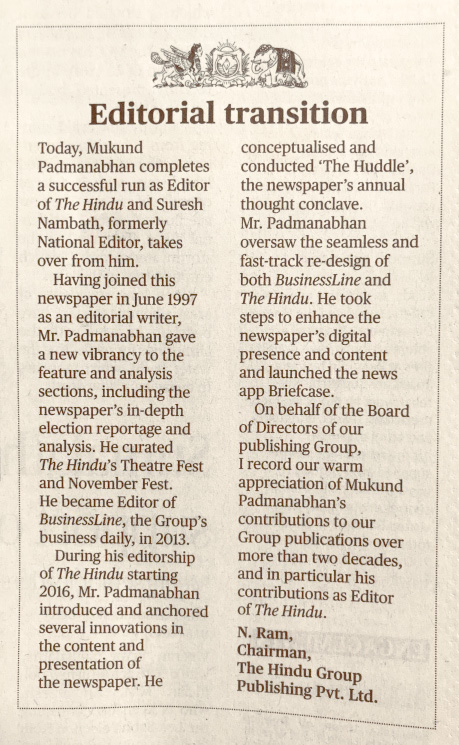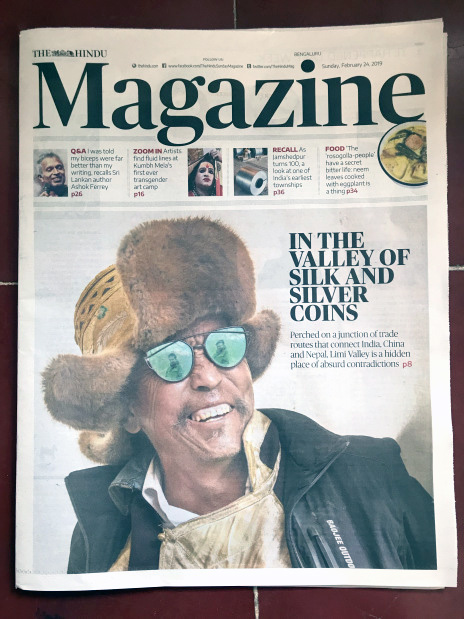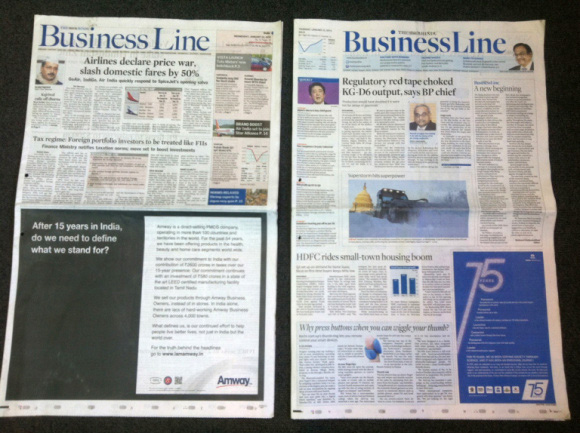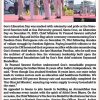Goa is abuzz with excitement as vintage bike and car owners, users, collectors and fans are decking […]

Rare Tribute To Retiring Editor Mukund Padmanabhan
July 06- July 12 2019, Media July 5, 2019For the first time in the history of Indian journalism the management of the Hindu acknowledged the contribution of the retiring editor Mukund Padmanabhan on the front page
The change of editorship at Indian media houses is (usually) a sinister cloak-and-dagger affair, done in the dead of night sans any grace. Publishers rarely ever feel the need to inform readers why Editor X has left or why Editor Y has come in.
Not so, The Hindu.
Three months ago, the “Mountroad Mahavishnu” announced on its front page that incumbent Mukund Padmanabhan would make way, at the end of February upon attaining superannuation, for a new Editor to take over. And so it was on March 1, 2019.
Here, Mukund Padmanabhan, who edited The Hindu for three years, and its sister daily, The Hindu Business Line, for three years before that, talks about his life and times as helmsman of India’s third largest English daily.
Q: N Ram, chairman of The Hindu Publishing Group, publicly acknowledged your tenure on the front page of the paper on the “Editorial Transition“. How do you view your stint?
Mukund Padmanabhan: That was a kind and gracious gesture from him and the board of the company, which I am very grateful for. I believe it is not for me but for others — and this includes readers — to assess how I did. As for me, I tried my best to do my best.
Q: What was the high point and the low point, the successes and failures? What are you immensely proud of and deeply embarrassed about? What do you wish readers and colleagues (and compatriots in the profession) will remember you for?
MP: The high point for me was easily the refresh of the newspaper we did in early 2017, which included the launch of The Hindu on Sunday, and which involved a reimagining of almost every part of the newspaper.
I think I did not go far enough in strengthening our digital offering or make enough headway in the process of creating an integrated newsroom. And I regret this. We took some steps — freed up the Internet team to do their stories and videos, sent some copies web first, launched an app (Briefcase), and initiated the first steps towards going behind a paywall (we will be the first major Indian newspaper to do this). But they were not enough.
One of the dilemmas for people in my pay grade when it comes to the digital space, is how much one invests in this area, given that nobody has a clue about the returns such investments will fetch (if any at all). I have been saying, and for many years now, that this is an issue that needs to be addressed by the company’s board. One of the last things we did, was to sign off on a digital strategy draft proposal for the board’s approval. So, I hope the group takes this forward.
I hope my colleagues remember me, above all, for being fair, giving everyone a chance to express themselves, and have the confidence and freedom to disagree with me. Also, for thinking that I never allowed my personal likes or prejudices to colour my assessment of their work.
As for readers, I did my best to make everyone adhere to the rule that news and opinion must be clearly separated and delineated in the newspaper — by the way, this is laid down as a principle in The Hindu’s code of editorial values. In a media environment, where news and opinion are being increasingly fused (often very manipulatively), laying down the rule ran the risk of people saying we were too matter of fact, too staid, too boring. There are people that are fine with such melding, as long as this suits their political or other purposes. But the very point about having principles is that they must be adhered to irrespective of one’s personal beliefs — and I hope readers believe we kept news and opinion separate. They may have had issues with some or many of our views, but I hope they believed we reported the news accurately and fairly.
Q: What were the challenges of leading a mainline daily newspaper with a hoary history, and with a rich legacy of serious journalism, in the modern age when attention spans are shrinking, readers have multiple outlets, and the competition is in a race to the bottom?
MP: The demand for serious journalism will remain, even in this age of digital disruption. Also, I am not sure whether attention spans are shrinking, but clearly, readers have a better idea of what they want today than before.
Ink-and-paper is definitely under threat and will face even more problems in the years to come. But newspapers and strong media organisations can reinvent themselves even if the medium changes. The content they have remains relevant.
There are clear signs emerging from the west, in this era of free digital news from multiple outlets, that people are willing to pay for quality journalism. The New York Times, Economist, The Financial Times, and Die Zeit are only four examples where the subscription model has worked. Ironically, it is the mass-consumption tabloids that peddle sex and sensationalism that people are unwilling to pay for.
There has been a lot of discussion about whether the model of giving away news for free has worked in economic terms. But journalists rarely introspect on how much it has damaged the practice of the profession. The craze for speed and the compulsion to grab more eyeballs or be picked up by Google has resulted in a proliferation or errors and the constant need to twist the news and sensationalise it. At the end of the day, we need people to pay for what we produce for them — not only for our sake but also for the sake of good journalism.
Q: Prior to your appointment as Editor of The Hindu, you were Editor of its sister-business daily The Hindu BusinessLine. Which of the two was more satisfying, impactful? How did the BL stint prepare you for the TH job?
MP: I was in charge of many sections of The Hindu before, but BusinessLine was the first newspaper I edited — so it is a kind of first love. I took that job with some apprehension, some doubts about my competence in handling a business newspaper. At The Hindu, I had contributed to virtually every section of the newspaper except business, so I was truly gobsmacked when I was offered the job.
As it was my first, I guess the effort to refashion and contemporise BusinessLine was the greater challenge. And yes, that stint, which afforded me with a considerable independence and freedom to usher in change, helped prepare me for The Hindu.

Q: Before you, and for a while now, the family-owned Hindu has had a very messy relationship with Editors, even for members of the family who became Editors. Did that weigh on your mind, tie your hands, curtail your journalism? Were you always looking over the shoulder?
MP: I would be lying if I said that I was unaware of the past or that it never crossed my mind. BusinessLine is under the radar for the most part, The Hindu isn’t. But there was no attempt at all to curtail or influence or control the journalism — in any case, I am not sure I would have been the right choice if that was the purpose of making the appointment.
I am really grateful to the board for the freedom I enjoyed — the changes that were ushered in would not have been possible without this. Disagreements with decisions I took were bound to have existed, but there was no overruling and no pressure at all. I keep hearing that the office of the editor has been diminished in some other media organisations — not in ours.
Q: You were Editor of the paper post 2014, widely acknowledged as the most difficult time for Indian news media. How much pressure did you specifically experience from the Narendra Modi government? How was displeasure conveyed? How often did his ministers or minions call to complain about or kill a story? Did Modi himself say anything to you when Editors from Tamil Nadu met him? How did you, as an Editor, view Modi’s diffident attitude to independent news media: one-way, no interviews, no press conferences in five years, and viewing all criticism as anti-Modi and therefore anti-India?
MP: It is a Prime Minister’s or Minister’s prerogative whether to give a one-on-one interview or even who to give one to. But it is truly unfortunate that we have not institutionalised a system where the Prime Minister addresses regular press conferences and takes open-ended questions from journalists. This is essential for the functioning of a healthy democracy.
In the absence of this, what we have had from Modi are select interviews, sometimes conducted via email and with no opportunities of follow-ups. This is unfortunate.
As for whether the Centre has put pressure on me over the past few years, I have been asked this question many times before. I keep hearing about the problems media organisations and journalists have undergone, but the truth is I have never faced one. Perhaps, we are headquartered too far down south and so out of mind? Or perhaps, there was a sense, and this is the more flattering interpretation, that we could not be pressured? I don’t really know.
I did have a call from a minister once when we stood by a report we had written despite a government counter. We argued about it at length on the phone and then agreed to disagree, which was fine. But I didn’t see this as pressure, just a difference in views.
As for the interaction with Modi, it was off the record and so it would be improper to repeat what he said. All I can say very broadly is that he did make a point about The Hindu and its coverage of him over the years.

Q: By the time you took over as Editor. The Times of India was already entrenched in Chennai with rising circulation and revenue. How did you see ToI as competition? What do you think they are doing right that seems to work with readers and advertisers? Was it easy to resist the temptation to dumb down to match ToI?
MP: The ToI is competition but there was absolutely no pressure to dumb down to compete with them. In fact, if you consider their Chennai offering, it has less fluff than other editions — which suggests that it is they have made some changes with The Hindu in mind. Despite being in Chennai for so many years, the ToI has chosen not to have its circulation audited by the Audit Bureau of Circulation. So it’s hard to say how much it distributes and at what price.
The ToI has deep pockets and does certain things in the news area very well, but I think The Hindu occupies a different niche. It would be silly, possibly even suicidal, to mimic what it does. As for advertising, we have a policy against carrying paid news and ensure that the distinction between what is news and advertising is not breached.
Q: The Hindu went through a relaunch a year after you came in, with Aurobind Patel redesigning it. What did it achieve for the paper and its readership? Was it, in the end, too staid? Is that why the Sunday magazine is now a tabloid?
MP: If a clean minimalist content-led design is staid, then I am guilty. I am not a great fan of clutter and the use of elements for the mere sake of ‘enhancing’ the design. Both Aurobind Patel and I believe that every element must have a larger editorial reason behind it. Our earlier designer Mario Garcia thought similarly — he disliked putting in too many colours and elements or making what he called “a fruit salad”.
What we did on Sunday is to incorporate most of the templated features as well as the content in the earlier Magazine into one product. We also threw some new things in. We felt this would provide a better reading experience and would be easier to carry around for the entire week. The content has not been dumbed down and there is a vast difference between a tabloid and tabloidisation.
Q: How did you, as an old school print journalist, deal with the demands of the digital age? How did you find see the social media impact in the newsroom? How did you prepare your journalists to cope, to tweet, to do Facebook, etc?
MP: I am not a great fan of the way social media is used by many journalists. I cut my teeth believing that as a journalist my job was to keep my views to myself, keep a critical distance from all your sources — whether politicians, industrialists or bureaucrats — even as you maintain a contact with all of them. That your sources should trust you because they believe you are fair and not because you are their friend, confidante or publicist.
Today, many reporters have no compunctions about airing their opinions on social media. We had a social media advisory in place, put together with the help of our Readers’ Editor and based on best practices recommended by journalistic organisations and followed by newspapers in other parts of the world. But, truth be told, the advisory has not been internalised by all.
I find social media a toxic place and the more I read about the algorithms and the way they work, the more convinced I am that it has (perhaps inadvertently) created echo chambers, divided people, polarised society, and lowered the standards of debate. A good illustration is the debate on intolerance — sometimes it seems to be fought between two intolerant camps accusing each other of the very same thing.
You refer to me as an old school print journalist, which is polite. On the issue of social media, some of my colleagues believe I was a dinosaur!
Q: How did you energise yourself on the job? Which newspapers, TV stations, websites did you look up to? How many books would you find the time to read? How did you relax?
MP: I like the Indian Express, my former newspaper, a reporter’s newspaper and one I have a great fondness for. As far as websites go, I read The Print, which I enjoy. Both are run by fine editors. Frankly, I don’t watch a lot of TV and have read much less than I have wanted to.
Q: What do you wish journalism students and young journalists would do to prepare themselves for a fulfilling career in the newsroom of the future?
MP: I used to teach courses for post-graduate students in media law and advanced writing as an adjunct faculty in a university in Manila, the Philippines. I think the most important thing is for students to get the basics right. When I interview young journalists today, some of them from j-schools, I find they have a lot to say by way of opinion, but much less to show in terms of practical skills. I think we need better skilling going forward, much wider skills as we are bound to migrate to a multi-media environment.
Q: And, finally, what next for Mukund Padmanabhan?
MP: Lots of little things, I hope. I have a job offer as a Professor of Public Practice in a new not-for-profit private university called Krea, which is located north of Chennai and which opens its doors this academic year. I am really impressed with the people who founded it and run it. I will be working in a part-time capacity there and hopefully will have time to do other things as well.
Courtesy: Indian Journalism Review















